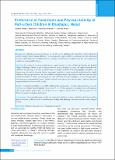Please use this identifier to cite or link to this item:
https://hdl.handle.net/20.500.14356/1668| Title: | Preference of Food-items and Physical Activity of Peri-urban Children in Bhaktapur, Nepal |
| Authors: | Vaidya, Abhinav Oli, Natalia Krettek, Alexandra Eiben, Gabriele |
| Citation: | VaidyaA., OliN., KrettekA., & EibenG. (2017). Preference of Food-items and Physical Activity of Peri-urban Children in Bhaktapur, Nepal. Journal of Nepal Health Research Council, 15(2), 150-158. https://doi.org/10.33314/jnhrc.v15i2.1054 |
| Issue Date: | 2017 |
| Publisher: | Nepal Health Research Council |
| Keywords: | Children Diet Preferences Nepal Physical activity |
| Series/Report no.: | May-Aug, 2017;1054 |
| Abstract: | Abstract Background: Though cardiovascular diseases are mostly seen in adulthood, the foundation of diet and physical activity is largely formed during childhood. The study aimed to explore children’s preference for diet and physical activity in a peri-urban area of Nepal because this is an important dimension to explore in the life-course approach to combat non-communicable diseases. Methods: We conducted a cross-sectional study to enquire young peri-urban children of Duwakot and Jhaukhel villages of Bhaktapur district, Nepal on their preferences for diet and physical activity. All eligible households with children in the age range 5-10 years as enlisted from the Jhaukhel-Duwakot Health Demographic Surveillance Site database were selected for the study. Twelve enumerators visited the selected households and facilitated the eligible children to fill in the questionnaire. We used a child-friendly photo-assisted questionnaire with face-scales that easily enabled the children to select a particular preference for each of the food item and physical activity. During analysis, food items were categorized into ‘green’, ‘yellow’ and ‘red’ on the basis of their nutritive values. Physical activity was categorized based on severity of the activity. Results: Four hundred and thirty seven children filled up the questionnaires. Overall, median preference scores for ‘red’ food were higher than for healthier ‘green’ food (4.16 vs. 4.03), particularly, if mothers were self-employed. Likewise, the children preferred low over moderate-to-severe physical activity (4.16 vs. 3.50), and preference was affected by parents’ occupation and income. Conclusions: The study objectively revealed that most of the children preferred unhealthier food-items and low physical activities. It shall be useful to consider these findings while planning health promotional activities targeted at them. Keywords: Children; diet; preferences; Nepal; physical activity. |
| Description: | Original Article |
| URI: | http://103.69.126.140:8080/handle/20.500.14356/1668 |
| ISSN: | Print ISSN: 1727-5482; Online ISSN: 1999-6217 |
| Appears in Collections: | Vol 5 No 2 Issue 36 May-Aug 2017 |
Files in This Item:
| File | Description | Size | Format | |
|---|---|---|---|---|
| 1054-Article Text-2329-3-10-20170913.pdf | Fulltext Download | 301.4 kB | Adobe PDF |  View/Open |
Items in DSpace are protected by copyright, with all rights reserved, unless otherwise indicated.
